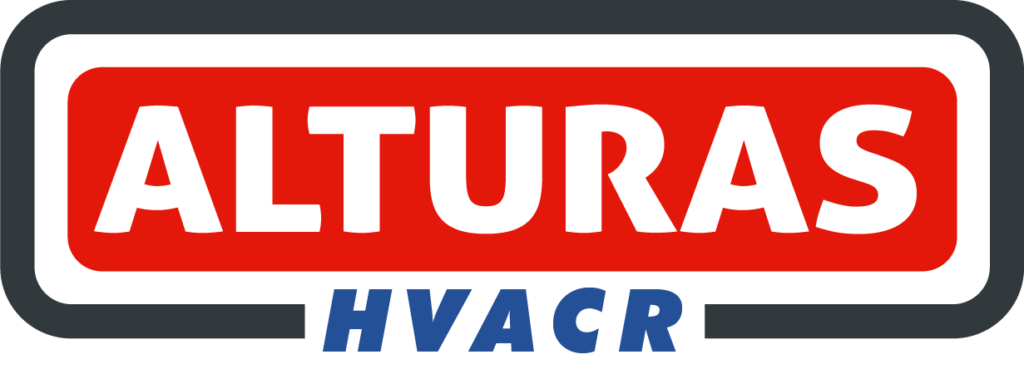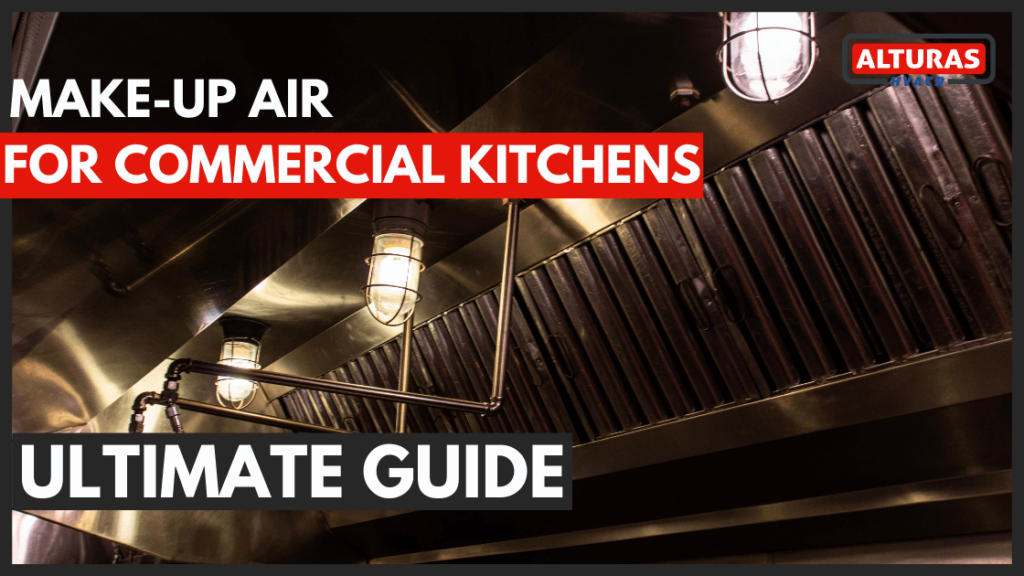Picture a busy restaurant kitchen during rush hour. The ovens are hot, the grills are sizzling, and pots are clanging loudly. This noisy scene is common in restaurant kitchens, but it also creates challenges for airflow. That’s where make-up air for kitchen hoods becomes essential.
Make-up air is a key part of any well-designed ventilation system for commercial kitchens. It helps keep staff comfortable and safe while ensuring the exhaust hood works properly. This guide explains make-up air in detail, discussing its importance, uses, and different solutions available
What is a Make-Up Air for Commercial Kitchen Hoods?
Kitchen exhaust hoods take away heat, smoke, grease, and smells from cooking. But, this strong exhaust makes low pressure inside the kitchen. This low pressure can cause some bad effects:
- Exhaust Struggles: When the pressure inside the kitchen goes down, the exhaust hood finds it hard to get rid of smoke and smells. This makes the air quality worse, and the kitchen can feel unpleasant to work in.
- Gases Flow Back: Low pressure can pull in air from nearby areas. This air might have pollutants or even pull flames out of cooking machines. This is very dangerous and unsafe.
- Workers Feel Uncomfortable: A big difference in pressure can make workers feel tired and give them headaches.
Fresh air comes into the kitchen through the make-up air system. This new air helps balance the air pressure, supporting effective kitchen ventilation. It stops smoke and smells from getting pulled back in. The exhaust fans and air fans work better too, improving overall airflow. As a result, the kitchen feels more comfortable for the workers.
Importance of Make-Up Air for Commercial Kitchen Hoods
There are several compelling reasons why make-up air is essential for any commercial kitchen:
- Safety: It is very important to stop air from moving backward. A rule called NFPA 96 says that we must have systems to bring in outside air. This is so there is not too much negative pressure inside.
- Efficiency: A hood that works well removes heat, smoke, and grease. This stops buildup that could cause fires.
- Comfort: When the air flows are balanced, the kitchen is a better place to work. Staff feel good and can work better.
- Energy Savings: Having the right system to bring in outside air can save energy. For example, a special system can prepare the incoming air before it enters the building. This makes the heating and cooling systems work less.
When is Make-Up Air Required for Kitchens?
Building rules and standards tell us when extra air is needed. The International Mechanical Code says extra air is required for exhaust systems in commercial kitchens with cooking appliances. It also says extra air is needed for exhaust hoods moving more than 400 cubic feet of air per minute.
Common Make-Up Air Solutions for Commercial Kitchens
Commercial kitchens need make-up air systems. The best system depends on the kitchen size, and exhaust hood power, and required temperature and humidity control. Here are some common make-up air solutions
1. Untempered Make-Up Air Units:
Outside air comes inside the kitchen through these units. They are the cheapest option. But, they do not control air temperature or moisture. In very hot or cold weather, you may feel uncomfortable.
- Pros: You pay less money when you buy them. Installing them is easy.
- Cons: The air temperature and wetness are not controlled. Extremely hot or cold weather could make you uncomfortable.
2. Heated Make-Up Air Units:
In cold weather, these units warm up the air coming inside. This makes the kitchen cozy and stops cold drafts. They are better than units that do not heat the air.
- Pros: More comfort compared to regular units that do not warm the air.
- Cons: They cost more money at first than regular units. They may not be needed in warmer places.
3. Dedicated Outdoor Air Systems (DOAS):
DOAS units provide a full solution for fresh air. They can clean, warm, cool, and dry incoming air, ensuring comfort and efficiency all year round.
- Pros: Precise control of temperature and humidity. Better air quality through filters. May save energy by reducing the load on the building’s air system.
- Cons: Highest upfront cost and complex installation compared to other options. Needs regular upkeep for best performance.
4. Rooftop Makeup Air Units (RTUs):
Does your kitchen have a small exhaust capacity? Is it less than 800 cfm? If so, installing a rooftop unit (RTU) could be a good choice. These units handle both exhaust and supply air. They mix them together and cool them down before sending the air back into the kitchen.
- Pros: Putting in an RTU is easier than a DOAS system. It may be cheaper for small kitchens.
- Cons: RTUs cannot control temperatures as well as DOAS. They may not work well for kitchens that need a lot of exhaust.
Expert Tips for Choosing the Right Make-Up Air System:
- Think about the weather: If it gets very hot or very cold where you live, you might need a heated or DOAS unit.
- Check the exhaust hood size: The make-up air unit should be able to move the same amount of air as the exhaust hood, or a little more.
- Save energy in the long run: DOAS units can help you save money over time because they can reuse heat from the air.
- Keep things comfortable and healthy: To make sure your kitchen feels good and has clean air, look for a system that controls temperature and humidity. This is especially important for big, busy kitchens.
- Ask an expert for advice: A professional Los Angeles HVAC company can look at your kitchen and tell you the best make-up air solution.
How to Install Makeup Air for Range Hoods
Materials Needed for Make-up Air Installation:
- Makeup air damper (motorized or passive)
- Ducting material (typically galvanized steel)
- Duct clamps
- Screwdriver or drill
- Measuring tape
- Duct tape
- Safety goggles
- Dust mask
- Pencil
- Level
Step-by-step Process for Makeup Air for Range Hoods:
- Find Out Needed Air Amount: Look at the instructions from the maker of your range hood. See how much air must come in. This will help pick the right makeup air damper size.
- Spot to Put the Damper: Find a good place near the range hood to install the makeup air damper. It is usually on an outside wall or close to the range hood.
- Get the Area Ready: Turn off power to the range hood at the breaker box. Clean up dust and junk from where you’ll install it.
- Mark Install Spots: Use a pencil and tape measure to mark where to make holes for the makeup air damper.
- Put in the Makeup Air Damper: Use screws and the right mounting pieces to secure the makeup air damper to the wall or ceiling. Make sure the damper is level and firmly attached.
- Connect the Ducts: Attach the ducting material to the outlet of the makeup air damper using duct clamps. Run the ducts to the range hood and connect them using duct clamps. Use duct tape to seal any joints or connections to stop air leaks.
- Install the Backdraft Damper (if needed): Install a backdraft damper in the duct near the makeup air damper. This stops air from flowing back when the range hood is off. Secure the backdraft damper with duct clamps.
- Test the Installation: Make sure the range hood is working correctly. Turn it on. Check if the makeup air system is bringing in fresh air. See if the damper opens when the range hood is on. It should close when the hood is off.
- Finalize the Installation: Use more clamps to hold the ducts tightly. Cover any open gaps or joints with duct tape. This will stop air from leaking out.
- Safety Check: Wear goggles and a mask during installation. Dust and debris can get in your eyes or lungs. Double check that everything is secure and sealed properly. You do not want any hazards or leaks.
Make-up air for range hood code
Range hoods sometimes need make-up air. This is air brought into the home. Building codes often require this. It is needed when the range hood pulls out a lot of air. Around 400 cfm is the common limit. Make-up air helps keep balanced air pressure. This prevents back-drafting of appliances that burn fuel. It also keeps indoor air quality good. Following local codes is important. Proper ventilation makes a home safe and efficient. Range hoods sometimes need make-up air, but if vents are difficult to open, it can affect the performance of cooking appliances and ventilation efficiency.
Also read: Commercial Kitchen Hood Code Requirements.
Conclusion
Make-up air is very important for any commercial kitchen. It helps maintain a comfortable and safe environment by providing necessary fresh air for proper heating and cooling. Without sufficient makeup air, the kitchen’s exhaust systems can create negative pressure, drawing in outdoor air through open doors and disrupting the flow of air to the dining area. A well-functioning makeup air unit or makeup air fan ensures that the kitchen exhaust hood operates effectively, preventing unsafe air conditions and maintaining the proper balance of replacement air. Understanding the significance of make-up air and the supplied air it provides is crucial for kitchens utilizing cooking appliances like stoves and grills.
By considering the NFPA 96 standards and calculating the required cubic feet for optimal exhaust fan performance, you can ensure the system meets the needs of your kitchen applications. A properly designed HVAC system that integrates the right amount of makeup air ensures the efficiency of your commercial kitchen exhaust, keeping your kitchen safe, comfortable, and compliant. With the right system, your kitchen will be a healthy and effective workspace for your workers.
Helpful for you: Commercial Vent Hood Motor Replacement
FAQs
When does it make sense to use a makeup-air unit that will be interlocked with the exhaust fan in addition to a rooftop unit?
Many places need good airflow and quality. Like kitchens, labs, and factories. These places have a lot of exhaust. The exhaust fan takes air out. To keep air flowing well, a makeup air unit brings fresh air in. It works with the fan. This unit also works with a rooftop unit. The rooftop unit helps control air temperature and quality. Using all these together is a smart setup. It keeps the air fresh and at the right temperature. This system works great in commercial buildings.
What are the most common options available to make up the exhausted air?
Fresh air is needed inside buildings. There are different ways to get fresh air inside. One way is using direct outdoor air intake. Another way is using energy recovery ventilation or ERV. There is also heat recovery ventilation or HRV. Dedicated outdoor air systems or DOAS are used too. These systems help keep indoor air clean and comfortable. They bring in new air from outside. This new air replaces the old air that was removed.
Do I need makeup air for my range hood?
A range hood that exhausts over 400 cubic feet per minute may need makeup air. Makeup air balances indoor air pressure and follows building codes. You should check local rules and your range hood details to know what is required.

